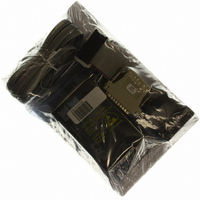ER3-1M TechTools, ER3-1M Datasheet - Page 19

ER3-1M
Manufacturer Part Number
ER3-1M
Description
EMULATOR EPROM ECONOROM III 1MEG
Manufacturer
TechTools
Series
EconoROM™ IIIr
Type
Memoryr
Datasheet
1.ER3-256.pdf
(24 pages)
Specifications of ER3-1M
Contents
ER3 EconoROM III Emulator, Cables (Daisy-chain, LPT and Target) and more
For Use With/related Products
EPROMs
For Use With
CBL08-25 - 25 FT DOWNLOAD CABLE UPGRADEC32D-6 - 6" TARGET CABLE IDC TO 32PIN DIPC28D-6 - 6" TARGET CABLE IDC TO 28PIN DIPPS-RT1 - EXTERNAL PWR SUPPLY
Other names
ER31M
Verifies, but target does not run
Target not being reset or not being released from reset
If the wrong reset output is being used or it is connected to the wrong spot on the target, it may not be
resetting the target during the download. We would get a good download, but the target was fetching
garbage during the transfer. Some processors will HALT, others will simply execute the random garbage
they received. In either event, the processor will not “know” to start over and execute the new code.
Try pushing your target’s reset button if it has one. If it starts to run, the reset line is connected to the
wrong place on the target.
Try removing the reset line. If the target starts running, you probably selected the wrong reset polarity.
If the emulator is running from an external power supply, try removing the reset line and cycling TARGET
power. If the target now comes up and runs, the reset signal connection was wrong. While you could do
this after each load, we highly recommend correcting the reset problem to make resets automatic and to
prevent the target from running garbage during the download. The reset line also ensures proper power-up
sequencing by preventing the target from fetching code before the emulator has had a chance to enable its
target-side buffers.
Emulator device size set wrong.
The device SIZE configuration affects how many target address lines are enabled. The file will download
and verify correctly as long as the file is less than or equal the SIZE setting and the maximum emulator size.
If the size is set larger than the device you are emulating, some extra address lines will be enabled. The
target may be driving these lines high or NOT AT ALL. This will either warp the addressing or cause
random address changes. Ensure you are configuring the SIZE to match the device you are emulating.
File too large
If the file size exceeds the configured device size, the target will not be able to access the entire file. If the
emulator is configured correctly and the file is larger than the device setting, your code has just outgrown its
space. If you are emulating the maximum size device the target is wired to accept, you will have to reduce
the code size. If the target has some unused space contiguous to the current EPROM space, you may be
able to modify the target board to accept a larger EPROM. This would typically involve adding another
address line to the socket and possibly modifying the EPROM chip select decodes. Of course you would
need to re-configure the emulator for the larger device as well (if it has room to spare).
Wrong PLCC or other adapters used.
Any adapter used between the target cable and the target socket itself has the potential of introducing errors.
In particular, PLCC footprints vary by EPROM size, model and manufacturer. In general, small EPROMs
(<1Mbit) generally have one pin out and larger EPROMs have a different pin out. Most FLASH chips are
pinned out like large EPROMs. However, SOME small FLASH are wired like SMALL EPROMs. In
general, large devices (>=1Mbit) use a 32 pin DIP to 32 pin PLCC adapter. Smaller devices usually need a
28 pin DIP to 32 pin PLCC adapter but MIGHT need the 32 pin version. Give us a call if you are not sure.
EconoROM III User’s Manual
15
Copyright © 2000, TechTools




















